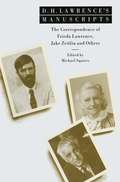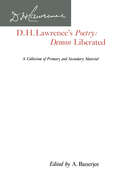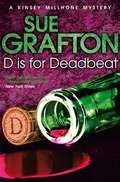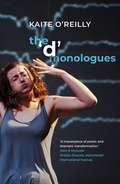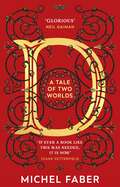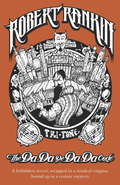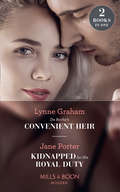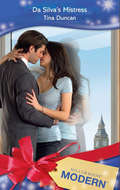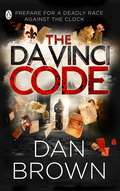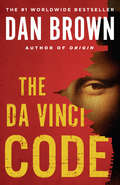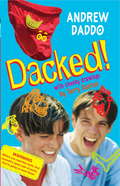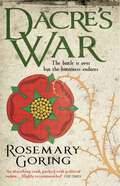- Table View
- List View
D. H. Lawrence, Technology, and Modernity
by Indrek MännisteWhile the dehumanizing effects of technology, modernity, and industrialization have been widely recognized in D. H. Lawrence's works, no book-length study has been dedicated to this topic. This collection of newly commissioned essays by a cast of international scholars fills a genuine void and investigates Lawrence's peculiar relationship with modern technology and modernity in its many and varied aspects. Addressing themes such as pastoral vs. industrial, mining, war, robots, ecocriticism, technologies of the self, film, poetic devices of technology, entertainment, and many others, these essays help to reevaluate Lawrence's complicated standing within the modernist literary tradition and reveal the true theoretical wealth of a writer whose whole life and work, according to T.S. Eliot, "was an assertion of what the modern world has lost."
D. H. Lawrence, Transport and Cultural Transition: 'A Great Sense of Journeying'
by Andrew F. HumphriesThis book discusses D. H. Lawrence’s interest in, and engagement with, transport as a literal and metaphorical focal point for his ontological concerns. Focusing on five key novels, this book explores issues of mobility, modernity and gender. First exploring how mechanized transportation reflects industry and patriarchy in Sons and Lovers, the book then considers issues of female mobility in The Rainbow, the signifying of war transport in Women in Love, revolution and the meeting of primitive and modern in The Plumed Serpent, and the reflection of dystopian post-war concerns in Lady Chatterley’s Lover. Appealing to Lawrence, modernist, and mobilities researchers, this book is also of interest to readers interested in early twentieth century society, the First World War and transport history.
D. H. Lawrence, Transport and Cultural Transition: 'A Great Sense of Journeying'
by Andrew F. HumphriesThis book discusses D. H. Lawrence’s interest in, and engagement with, transport as a literal and metaphorical focal point for his ontological concerns. Focusing on five key novels, this book explores issues of mobility, modernity and gender. First exploring how mechanized transportation reflects industry and patriarchy in Sons and Lovers, the book then considers issues of female mobility in The Rainbow, the signifying of war transport in Women in Love, revolution and the meeting of primitive and modern in The Plumed Serpent, and the reflection of dystopian post-war concerns in Lady Chatterley’s Lover. Appealing to Lawrence, modernist, and mobilities researchers, this book is also of interest to readers interested in early twentieth century society, the First World War and transport history.
D.H. Lawrence, Travel and Cultural Difference
by N. RobertsThis study of Lawrence's travel writings is the first book-length study to approach the subject with reference to contemporary post-colonial theory. Focusing on the writings of 1921-25, the period when Lawrence was most intensely engaged in travel, it includes chapters on Sea and Sardinia, Kangaroo, The Plumed Serpent and the essays and stories inspired by Lawrence's experience of the New World.
D.H. Lawrence's Australia: Anxiety at the Edge of Empire
by David GameThe first full-length account of D.H. Lawrence’s rich engagement with a country he found both fascinating and frustrating, D.H. Lawrence’s Australia focuses on the philosophical, anthropological and literary influences that informed the utopian and regenerative visions that characterise so much of Lawrence’s work. David Game gives particular attention to the four novels and one novella published between 1920 and 1925, what Game calls Lawrence’s 'Australian period,' shedding new light on Lawrence’s attitudes towards Australia in general and, more specifically, towards Australian Aborigines, women and colonialism. He revisits key aspects of Lawrence’s development as a novelist and thinker, including the influence of Darwin and Lawrence’s rejection of eugenics, Christianity, psychoanalysis and science. While Game concentrates on the Australian novels such as Kangaroo and The Boy in the Bush, he also uncovers the Australian elements in a range of other works, including Lawrence’s last novel, Lady Chatterley’s Lover. Lawrence lived in Australia for just three months, but as Game shows, it played a significant role in his quest for a way of life that would enable regeneration of the individual in the face of what Lawrence saw as the moral collapse of modern industrial civilisation after the outbreak of World War I.
D.H. Lawrence's Australia: Anxiety at the Edge of Empire
by David GameThe first full-length account of D.H. Lawrence’s rich engagement with a country he found both fascinating and frustrating, D.H. Lawrence’s Australia focuses on the philosophical, anthropological and literary influences that informed the utopian and regenerative visions that characterise so much of Lawrence’s work. David Game gives particular attention to the four novels and one novella published between 1920 and 1925, what Game calls Lawrence’s 'Australian period,' shedding new light on Lawrence’s attitudes towards Australia in general and, more specifically, towards Australian Aborigines, women and colonialism. He revisits key aspects of Lawrence’s development as a novelist and thinker, including the influence of Darwin and Lawrence’s rejection of eugenics, Christianity, psychoanalysis and science. While Game concentrates on the Australian novels such as Kangaroo and The Boy in the Bush, he also uncovers the Australian elements in a range of other works, including Lawrence’s last novel, Lady Chatterley’s Lover. Lawrence lived in Australia for just three months, but as Game shows, it played a significant role in his quest for a way of life that would enable regeneration of the individual in the face of what Lawrence saw as the moral collapse of modern industrial civilisation after the outbreak of World War I.
D. H. Lawrence’s Language of Sacred Experience: The Transfiguration of the Reader
by C. BurackThis book demonstrates how D.H. Lawrence's prophetic ambitions impelled him to create novels that would radically transform the consciousness of his readers. Charles Burack argues that Lawrence's major novels, beginning with The Rainbow , are structured as religious initiation rites that attempt to break down the reader's normative mindset and to evoke new, numinous experiences of self and world. Through careful analysis of narrative structure, literary technique, and sacred discourses, Burack shows that Lawrence tries to initiate the reader into his own version of religious vitalism. Unlike most initiations that conclude with powerful affirmations, Lawrence's novels generally end with an attempt to subvert the formation of new religious dogmas and to encourage sacred-erotic exploration.
D. H. Lawrence’s Manuscripts: The Correspondence of Frieda Lawrence, Jake Zeitlin and Others (pdf)
by Michael SquiresD.H.Lawrence's Poetry: Demon Liberated
by Amitava BanerjeeThis book brings together articles and essays published over a period of about 60 years. These discussions lead to an assessment of Lawrence's poetry, showing how he has been regarded as a poet over the years, as well as analyzing the intrinsic merit of his poetry.
D is for Deadbeat: A Kinsey Millhone Mystery (Kinsey Millhone Alphabet series #4)
by Sue GraftonD is for Deadbeat is the fourth in the Kinsey Millhone mystery series by Sue Grafton.My name is Kinsey Millhone. I’m a private investigator . . . female, single and self-employed, with a constitutional inability to work for anyone else. I’m a purist when it comes to justice, but I’ll lie at the drop of a hat. Inconsistency has never troubled me . . . It was late October, the day before Halloween. He introduced himself as Alvin Limardo. The job he hired Kinsey to do seemed easy enough . . . until his cheque bounced. His real name was Dagett. John Dagett. Ex-con. Inveterate liar. Chronic drunk. And dead. The cops called it an accident – death by drowning. Kinsey wasn’t so sure. The man, it seemed, had a lot of enemies . . .
D is for Death: Meet Dora Wildwood, historical crime's brilliant new heroine!
by Harriet F. Townson'A little bit Margery Allingham with hints of Mitford, definite tones of Eva Ibbotson and as delightful as I Capture the Castle, D is for Death is an instant classic. I loved it so much' MARIAN KEYES'A charming and authentic ode to Golden Age crime fiction and to books in general. In a genre replete with world-weary cynicism, Dora Wildwood makes for an endearingly optimistic feminist sleuth' CHRIS BROOKMYREMeet Dora Wildwood: runaway bride, book lover, and aspiring detective. Likes: solving crimes, peppermint creams, trousers and her own independence.Dislikes: cracked book spines, tyrannical behaviour, beetroot.1935. Dora'son the first train to London, having smuggled herself out of the house in the middle of the night to escape her impending marriage. But unluckily for her, Dora's fiance is more persistent than most and follows.As Dora alights at Paddington station, she is immediately forced to run from the loathsome Charles Silk-Butters. She ducks into the London Library to hide and it is there, surrounded by books, where she should feel most safe, that Dora Wildwood stumbles across her first dead body.Having been thrown into the middle of a murder scene, it's now impossible to walk away. Indeed, Dora's certain she will prove an invaluable help to the gruff Detective Inspector Fox who swiftly arrives on the scene. For as everyone knows, it's the woman in the room who always sees more than anyone else: and no one more so than Dora herself...D is for Death heralds the launch of a brilliant historical crime series that marries the quality of Dorothy L. Sayers with the ingenuity of Janice Hallett - and in Dora Wildwood introduces a character with the spark and gusto of Enola Holmes and the detective skill of Miss Marple. It is the debut crime novel from bestselling author Harriet Evans, writing as Harriet F. Townson.'A glorious, stylish story of passion, poison and peril' LUCY DIAMOND'What a world, what a plot, what a cast - a masterpiece!' VERONICA HENRY'So good and funny ... bristling with loveable characters' LAURA WOOD'I am now a Dora addict ... so wonderful' NATASHA POLISZCZUK
The 'd' Monologues (Oberon Modern Playwrights)
by Kaite O'ReillyFrom biting satire to crip’ pride, observational comedy to poignant revelations of life in contemporary Britain and beyond, these texts challenge and subvert ingrained preconceptions of difference and disability, relishing all the possibilities of human variety.An atypical body of work – solo, choral and ensemble monologues for D/deaf and disabled performers, inspired by lived experience.
The D S Cupidi Omnibus (1-5)
by William Shaw*A GRIPPING OMNIBUS FEATURING THE NEWEST NOVEL IN THE DS ALEXANDRA CUPIDI SERIES*The Birdwatcher is a crime novel of suspense, intelligence and powerful humanity about fathers and sons, grief and guilt and facing the darkness within...Salt Lane - DS Alexandra Cupidi has done it again. She should have learnt to keep her big mouth shut, after the scandal that sent her packing - resentful teenager in tow - from the London Met to the lonely Kent coastline. Murder is different here, among the fens and stark beaches...Deadland brilliantly captures Kent and its social divisions, it's a crime thriller that's as ingeniously unguessable as it is moving and powerful.Grave's End confronts the crisis in housing, environmentalism, historic cases of abuse and the protection given to badgers by the law. The Trawlerman shows that deceit can be found in the most unlikely places. The brooding waters of the Kent coastline offer an ominous backdrop for this lively page-turner of corruption, mental health and the complexities of human connection.'If you're not a fan yet, why not?' VAL MCDERMID
D (A Tale of Two Worlds): A modern-day Dickensian fable
by Michel Faber'Glorious. A story that will be found and enjoyed and dreamed about for years to come' NEIL GAIMAN'Faber's writing is so dizzyingly accomplished that he is able to convince you that just sometimes, the old stories are the best ones' GUARDIAN__________________________A modern-day Dickensian fable and a celebration of friendship and humanity, by the acclaimed author of The Crimson Petal and the White.It all starts on the morning the letter D disappears from the language. First, it vanishes from her parents' conversation at breakfast, then from the road signs outside. Soon the local dentist and the neighbour's Dalmatian are missing, and even the Donkey Derby has been called off. Though she doesn't know why, Dhikilo is summoned to the home of her old history teacher Professor Dodderfield and his faithful Labrador, Nelly Robinson. And this is where our story begins.Set between England and the wintry land of Liminus, a world enslaved by the monstrous Gamp and populated by fearsome, enchanting creatures, D (Tale of Two Worlds) is a mesmerising tale of friendship and bravery in an uncertain world. Told with simple beauty and warmth, its celebration of moral courage and freethinking is a powerful reminder of our human capacity for strength, hope and justice.-------------------------------------'If ever a book like this was needed, it is now. Dhikilo is a splendid heroine for our time: She stands for kindness, honesty and humanity. Her triumph will have readers rejoicing' DIANE SETTERFIELD'YA readers will love it, but Faber's brio and bubbly ingenuity will delight adult readers too' DAILY MAIL'In this rather ebullient and lovely new novel by Michel Faber ... older children and fully-grown adults will certainly find much to relish in it' THE SCOTSMANA 'Biggest Books of Autumn 2020; What to read in a very busy year' title: GUARDIAN'A firecracker of a novel' STUART KELLY, EDINBURGH FESTIVAL 2020'Dazzling' INDEPENDENT
The Da-Da-De-Da-Da Code
by Robert RankinJonny Hooker has been picked as a WINNER! and all he has to do to claim his prize is to solve the Da-da-de-da-da Code. Jonny knows that beat; it always turns up in popular music - like 'Waltzing Matilda', or the National Anthem. And it has something to do with the Devil's Chord. And with Robert Johnson (who sold his soul to the Devil), whose blues influenced a generation of musicians. And it definitely has something to do with Elvis, who is still alive and rocking (of course). And with the Secret Parliament of Five, who meet in Gunnersbury Park to dictate world affairs. And when he solves the Da-da-de-da-da Code, Jonny will also discover why all the most famous rock musicians die aged twenty-seven, the truth about raising an ancient god, and the destruction of the world. It's all right there in the music. All Jonny has to do is to crack that code. Before he dies on Monday.
Da Happie Laand
by Robert Alan JamiesonShortlisted for the Creative Scotland and Scottish Mortgage Investment Trust Fiction Award 2011An experimental novel on a grand scale, beautifully carried through. A Perth minister takes in a traumatised stranger who calls himself 'the son and heir to being lost'. When the stranger disappears, the events leading up to and following on from this are revealed. Shifting perspectives from a contemporary mystery to a history of Shetland and emigration, it extends the idea of Scottish empire and diaspora imaginatively, while addressing notions of being and belonging in 21st century Scotland. BACK COVER Hit wis kynda da promised land in mony wyes, da Happie Laand across da sea...In the summer of the year of the Millennium, a barefoot stranger comes to the door of the manse for help. But three days later he disappears without trace, leaving a bundle of papers behind.Da Happie Laand weaves the old minister's attempt to make sense of the mysteries left behind by his 'lost sheep' with an older story relating the fate of a Zetlandic community across the centuries - the tales of those people who emigrated to New Zetland in the South Pacific to build a new life in the promised land, and those who stayed behind. REVIEWS A work of complexity, a novel to be savoured and one that will only get better with age. NEW SHETLANDER Jamieson achieves something quite extraordinary - [he] combines a compelling modern mystery with 500 years of history in a typically experimental style that leaves many of his contemporaries lagging THE LIST Robert Alan Jamieson's strange masterpiece Da Happie Laand haunts dreams and waking hours, as it takes my adopted home of Shetland, twisting it and the archipelago's history into the most disturbing, amazing slyly funny shapes. THE SUNDAY HERALD
Da Rocha's Convenient Heir: Da Rocha's Convenient Heir (vows For Billionaires) / Kidnapped For His Royal Duty (stolen Brides) (Vows for Billionaires #3)
by Lynne GrahamAn heir for the da Rocha legacy… Secured with a ring!
Da Rocha's Convenient Heir: Da Rocha's Convenient Heir (vows For Billionaires) / Kidnapped For His Royal Duty (stolen Brides) (Mills And Boon Modern Ser.)
by Lynne Graham Jane PorterDa Rocha’s Convenient Heir by Lynne Graham
Dà Shamhradh ann an Raineach
by Graham CooperDà Shamhradh ann an Raineach is a historical novel written in Scottish Gaelic. It is set in 18th century Edinburgh and rural Perthshire, 20 years after the Battle of Culloden, a time of rapid social change and development in areas such as medicine, printing, the Church, the Gaelic language and agriculture. The novel is based on the facts that are known of the life of Dugald Buchanan, the poet and schoolteacher who made a major contribution to the first translation of the New Testament into Gaelic from the original Greek. He oversaw the printing of the New Testament in Edinburgh in 1767, the same year in which his own book of Spiritual Songs was published. These poems were to become enormously influential throughout the Gaelic speaking world. The greater part of the novel describes the last two years of his life and is narrated by his wife, Margaret. She outlived him by over 40 years and was in a position to look back over the tragic events which had struck the Buchanan family. As a result, the story ultimately becomes her own as much as that of Dugald.
Da Silva's Mistress (Mills And Boon Modern Ser. #2)
by Tina DuncanHired for revenge – as his mistress! Merciless Luca da Silva makes it his business to keep his friends close – and his enemies closer. And the next item on the tycoon’s agenda is revenge! Believing the da Silva family name is under threat, the powerful Italian goes straight for the source – beautiful Morgan Marshall.
The Da Vinci Code: (robert Langdon Book 2) (Robert Langdon Ser. #Bk. 2)
by Dan BrownABRIDGED EDITIONIf I die, the truth will be lost for ever . . . I must pass on the secret. History professor Robert Langdon receives an urgent late-night phone call while on business in France: the curator of the Louvre in Paris has been brutally murdered inside the museum. Alongside the body, police have found a series of baffling codes and need Langdon's help to decipher them. When Langdon and a French cryptologist, Sophie Neveu, begin to sort through the bizarre riddles, they find a trail that leads to the works of the famous artist and inventor Leonardo Da Vinci. As the clues unfold, Langdon and Neveu must decipher the code and quickly assemble the pieces of the puzzle before a stunning historical truth is lost forever . . .
The Da Vinci Code
by Dan BrownThe Da Vinci Code is a 2003 mystery thriller novel by Dan Brown. It is Brown's second novel to include the character Robert Langdon: the first was his 2000 novel Angels & Demons. The Da Vinci Code follows "symbologist" Robert Langdon and cryptologist Sophie Neveu after a murder in the Louvre Museum in Paris causes them to become involved in a battle between the Priory of Sion and Opus Dei over the possibility of Jesus Christ and Mary Magdalene having had a child together. The novel explores an alternative religious history, whose central plot point is that the Merovingian kings of France were descended from the bloodline of Jesus Christ and Mary Magdalene, ideas derived from Clive Prince's “The Templar Revelation” (1997) and books by Margaret Starbird. The book also refers to The Holy Blood and the Holy Grail (1982) though Dan Brown has stated that it was not used as research material. The Da Vinci Code provoked a popular interest in speculation concerning the Holy Grail legend and Mary Magdalene's role in the history of Christianity. The book has, however, been extensively denounced by many Christian denominations as an attack on the Catholic Church, and consistently criticized for its historical and scientific inaccuracies. The novel nonetheless became a massive worldwide bestseller that sold 80 million copies as of 2009 and has been translated into 44 languages. In November 2004, Random House published a Special Illustrated Edition with 160 illustrations. In 2006, a film adaptation was released by Columbia Pictures.
The Da Vinci Code: (Robert Langdon Book 2) (Robert Langdon #2)
by Dan Brown*INCLUDES AN EXTRACT FROM ORIGIN,THE NEW THRILLER BY DAN BROWN: OUT NOW*---------------------------------------------------------------------------------------------------Harvard professor Robert Langdon receives an urgent late-night phone call while on business in Paris: the elderly curator of the Louvre has been brutally murdered inside the museum. Alongside the body, police have found a series of baffling codes. As Langdon and a gifted French cryptologist, Sophie Neveu, begin to sort through the bizarre riddles, they are stunned to find a trail that leads to the works of Leonardo Da Vinci - and suggests the answer to a mystery that stretches deep into the vault of history.Unless Langdon and Neveu can decipher the labyrinthine code and quickly assemble the pieces of the puzzle, a stunning historical truth will be lost forever...
Dacked!
by Andrew DaddoOkay, the surf's sweet, the sand's hot (so are the people on it), you're happily reading between the flags and one of these stories sneaks up behind you and...you're DACKED!Any minute, you won't be the only one laughing. So before you go any further, find yourself a spare pair of pants. You're going to need them.
Dacre's War
by Rosemary GoringPraise for After Flodden 'A swashbuckling tale in the best tradition of adventure fiction ... charged with melancholy and menace' - Times 'A highly readable tale that beautifully evokes the chaos in the aftermath of the disastrous battle' - Scottish Field 'A well-crafted tale which drives forward with unremitting pace' - Scotland on Sunday 'Very good indeed, and hugely enjoyable' - Allan Massie, Scotsman 'A compelling story that weaves deftly amongst historical fact and fiction' - We Love This Book '[A] beautiful and highly acclaimed debut novel' - Observer 'A fast-paced adventure story that will delight fans of the genre' - The Lady 'Goring has a fine story to tell, a keen sense of place, and the ability to evoke mood. It's a compelling and gripping novel' - Scotsman Dacre's War is a story of personal and political vengeance. Ten years after the battle of Flodden, Adam Crozier, head of his clan and of an increasingly powerful alliance of Borderers, learns for sure that it was Lord Thomas Dacre - now the most powerful man in the north of England - who ordered his father's murder. He determines to take his revenge. As a fighting man, Crozier would like nothing better than to bring Dacre down face to face but his wife Louise advises him that he must use more subtle methods. So he sets out to engineer Dacre's downfall by turning the machinery of the English court against him. A vivid and fast-moving tale of political intrigue and heartache, Dacre's War is set against the backdrop of the Scottish and English borders, a land where there is never any chance of peace.





